Civil Engineering Report: Air Quality, Impacts, and Solutions
VerifiedAdded on 2023/01/13
|9
|2806
|83
Report
AI Summary
This report delves into the critical intersection of air quality and civil engineering. It begins by highlighting the detrimental effects of poor air quality, including its impact on human health and the environment, with a specific focus on the role of internal combustion engine vehicles in exacerbating the problem. The report then explores the link between poor air quality and climate change, emphasizing the role of greenhouse gas emissions and the contribution of civil engineers to improving air quality. It discusses the positive impacts civil engineers can have on air quality through sustainable construction practices and the ethical considerations that must be addressed. The report also examines ethical implications and the importance of codes and practices within construction projects. It provides a comprehensive overview of the challenges and opportunities in this field, emphasizing the need for sustainable solutions and ethical practices within the civil engineering profession.

Civil Engineering
1
1
Paraphrase This Document
Need a fresh take? Get an instant paraphrase of this document with our AI Paraphraser

Contents
INTRODUCTION...........................................................................................................................3
MAIN BODY..................................................................................................................................3
CONCLUSION................................................................................................................................7
REFERENCES................................................................................................................................8
2
INTRODUCTION...........................................................................................................................3
MAIN BODY..................................................................................................................................3
CONCLUSION................................................................................................................................7
REFERENCES................................................................................................................................8
2

INTRODUCTION
Civil engineering is based on the professional that mainly deals with the construction design,
maintenance of physical environment. it may include structural components of buildings, canals,
bridges and railways. The report will discuss about the poor air quality within environment
where it directly impacts on the climate change due to increase use of internal combustion power
vehicle. Furthermore, the documentation will describe about the positive aspects of civil
engineers that should consider a professional ethical implication for improving air quality all
around.
MAIN BODY
Highlights the effects of poor air quality
A poor-quality air can seriously harmful for enterprise, human being because it has
increased the rate of pollution. In this way, Air quality has a direct impact on the human health as
well as environment. there are lot of source exits in regional and local area that will increase the
temperature of earth, depletion of ozone layer and climate changes. There are different types of
effects seen through poor air quality (Abadi, Mohammadi and Moattar, 2019). An air pollution
can be visible through brownish yellow colour of smog and invisible. On the other hand, A good
Air quality mainly refers to clear, unpolluted air which mainly involves the components from
across province. It provides the update the information by monitoring data that may affects on
the environment and health.
A poor air quality can be irritated throat, eyes and nose. Sometimes, it also causes of
breathing problem and other type of respiratory situation happens. Even healthy people can also
experience of health issues due to the poor air quality. It has increased the risk adversely effects
depend on the current health status.
The ground level ozone is also formed when it exists the organic compound and other
type of nitrogen oxides that react with the sun light. The primary source of buses, trucks, vehicle
and another type of construction equipment’s. In this way, ground level ozone directly reaches
the highest level in the summer days (Angın, Çubukçuoğlu and Gökçekuş, 2020). It has
generated the strong irritant that mainly cause of construction of airways. In order to increase
level of carbon dioxide on the earth which directly affects on the human being.
Apart from that Particulate matter is another type of complex mixture that consists of
sulphates, dust, tire rubber, smoke and metals. These are emitted in the form of smoke while
3
Civil engineering is based on the professional that mainly deals with the construction design,
maintenance of physical environment. it may include structural components of buildings, canals,
bridges and railways. The report will discuss about the poor air quality within environment
where it directly impacts on the climate change due to increase use of internal combustion power
vehicle. Furthermore, the documentation will describe about the positive aspects of civil
engineers that should consider a professional ethical implication for improving air quality all
around.
MAIN BODY
Highlights the effects of poor air quality
A poor-quality air can seriously harmful for enterprise, human being because it has
increased the rate of pollution. In this way, Air quality has a direct impact on the human health as
well as environment. there are lot of source exits in regional and local area that will increase the
temperature of earth, depletion of ozone layer and climate changes. There are different types of
effects seen through poor air quality (Abadi, Mohammadi and Moattar, 2019). An air pollution
can be visible through brownish yellow colour of smog and invisible. On the other hand, A good
Air quality mainly refers to clear, unpolluted air which mainly involves the components from
across province. It provides the update the information by monitoring data that may affects on
the environment and health.
A poor air quality can be irritated throat, eyes and nose. Sometimes, it also causes of
breathing problem and other type of respiratory situation happens. Even healthy people can also
experience of health issues due to the poor air quality. It has increased the risk adversely effects
depend on the current health status.
The ground level ozone is also formed when it exists the organic compound and other
type of nitrogen oxides that react with the sun light. The primary source of buses, trucks, vehicle
and another type of construction equipment’s. In this way, ground level ozone directly reaches
the highest level in the summer days (Angın, Çubukçuoğlu and Gökçekuş, 2020). It has
generated the strong irritant that mainly cause of construction of airways. In order to increase
level of carbon dioxide on the earth which directly affects on the human being.
Apart from that Particulate matter is another type of complex mixture that consists of
sulphates, dust, tire rubber, smoke and metals. These are emitted in the form of smoke while
3
⊘ This is a preview!⊘
Do you want full access?
Subscribe today to unlock all pages.

Trusted by 1+ million students worldwide
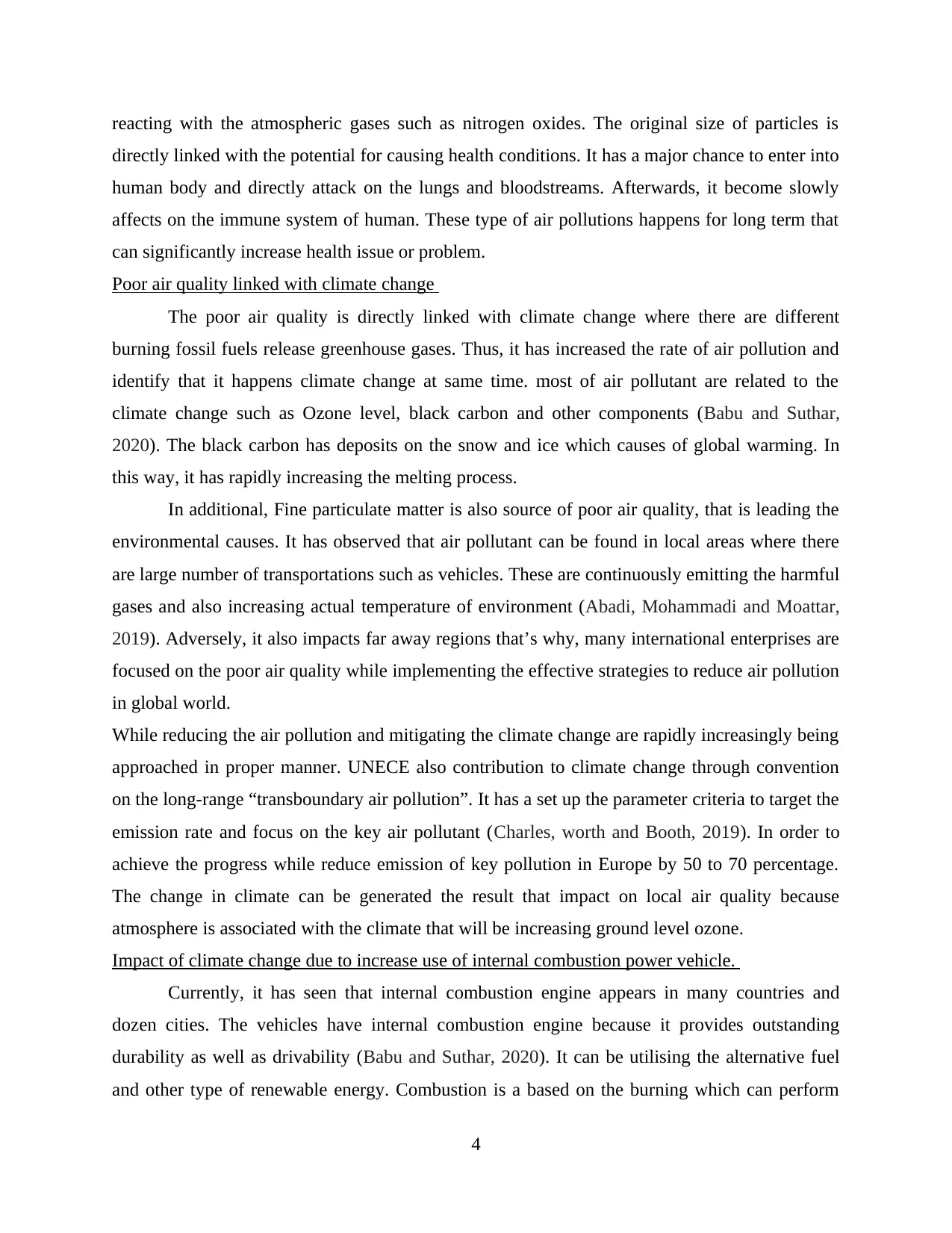
reacting with the atmospheric gases such as nitrogen oxides. The original size of particles is
directly linked with the potential for causing health conditions. It has a major chance to enter into
human body and directly attack on the lungs and bloodstreams. Afterwards, it become slowly
affects on the immune system of human. These type of air pollutions happens for long term that
can significantly increase health issue or problem.
Poor air quality linked with climate change
The poor air quality is directly linked with climate change where there are different
burning fossil fuels release greenhouse gases. Thus, it has increased the rate of air pollution and
identify that it happens climate change at same time. most of air pollutant are related to the
climate change such as Ozone level, black carbon and other components (Babu and Suthar,
2020). The black carbon has deposits on the snow and ice which causes of global warming. In
this way, it has rapidly increasing the melting process.
In additional, Fine particulate matter is also source of poor air quality, that is leading the
environmental causes. It has observed that air pollutant can be found in local areas where there
are large number of transportations such as vehicles. These are continuously emitting the harmful
gases and also increasing actual temperature of environment (Abadi, Mohammadi and Moattar,
2019). Adversely, it also impacts far away regions that’s why, many international enterprises are
focused on the poor air quality while implementing the effective strategies to reduce air pollution
in global world.
While reducing the air pollution and mitigating the climate change are rapidly increasingly being
approached in proper manner. UNECE also contribution to climate change through convention
on the long-range “transboundary air pollution”. It has a set up the parameter criteria to target the
emission rate and focus on the key air pollutant (Charles, worth and Booth, 2019). In order to
achieve the progress while reduce emission of key pollution in Europe by 50 to 70 percentage.
The change in climate can be generated the result that impact on local air quality because
atmosphere is associated with the climate that will be increasing ground level ozone.
Impact of climate change due to increase use of internal combustion power vehicle.
Currently, it has seen that internal combustion engine appears in many countries and
dozen cities. The vehicles have internal combustion engine because it provides outstanding
durability as well as drivability (Babu and Suthar, 2020). It can be utilising the alternative fuel
and other type of renewable energy. Combustion is a based on the burning which can perform
4
directly linked with the potential for causing health conditions. It has a major chance to enter into
human body and directly attack on the lungs and bloodstreams. Afterwards, it become slowly
affects on the immune system of human. These type of air pollutions happens for long term that
can significantly increase health issue or problem.
Poor air quality linked with climate change
The poor air quality is directly linked with climate change where there are different
burning fossil fuels release greenhouse gases. Thus, it has increased the rate of air pollution and
identify that it happens climate change at same time. most of air pollutant are related to the
climate change such as Ozone level, black carbon and other components (Babu and Suthar,
2020). The black carbon has deposits on the snow and ice which causes of global warming. In
this way, it has rapidly increasing the melting process.
In additional, Fine particulate matter is also source of poor air quality, that is leading the
environmental causes. It has observed that air pollutant can be found in local areas where there
are large number of transportations such as vehicles. These are continuously emitting the harmful
gases and also increasing actual temperature of environment (Abadi, Mohammadi and Moattar,
2019). Adversely, it also impacts far away regions that’s why, many international enterprises are
focused on the poor air quality while implementing the effective strategies to reduce air pollution
in global world.
While reducing the air pollution and mitigating the climate change are rapidly increasingly being
approached in proper manner. UNECE also contribution to climate change through convention
on the long-range “transboundary air pollution”. It has a set up the parameter criteria to target the
emission rate and focus on the key air pollutant (Charles, worth and Booth, 2019). In order to
achieve the progress while reduce emission of key pollution in Europe by 50 to 70 percentage.
The change in climate can be generated the result that impact on local air quality because
atmosphere is associated with the climate that will be increasing ground level ozone.
Impact of climate change due to increase use of internal combustion power vehicle.
Currently, it has seen that internal combustion engine appears in many countries and
dozen cities. The vehicles have internal combustion engine because it provides outstanding
durability as well as drivability (Babu and Suthar, 2020). It can be utilising the alternative fuel
and other type of renewable energy. Combustion is a based on the burning which can perform
4
Paraphrase This Document
Need a fresh take? Get an instant paraphrase of this document with our AI Paraphraser
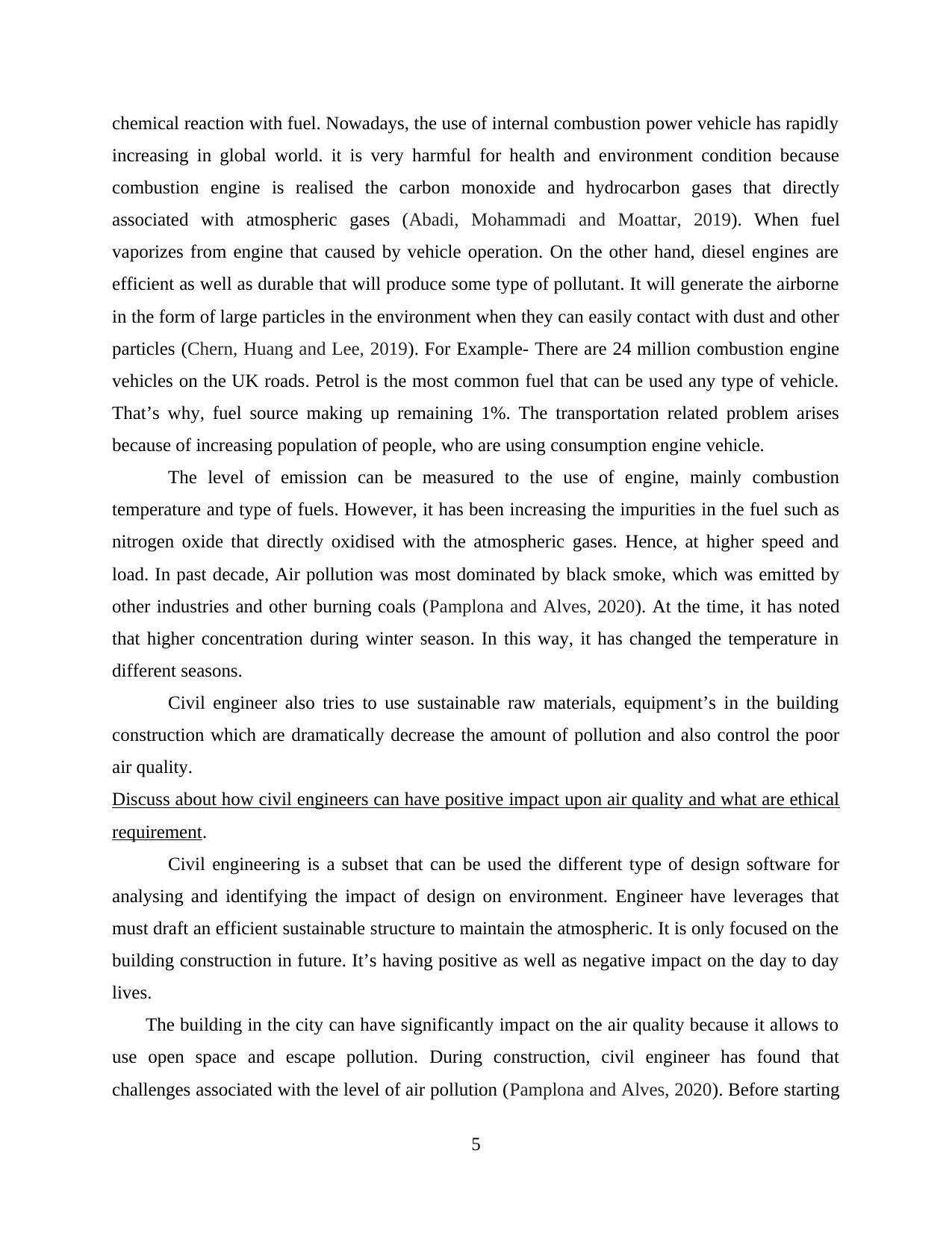
chemical reaction with fuel. Nowadays, the use of internal combustion power vehicle has rapidly
increasing in global world. it is very harmful for health and environment condition because
combustion engine is realised the carbon monoxide and hydrocarbon gases that directly
associated with atmospheric gases (Abadi, Mohammadi and Moattar, 2019). When fuel
vaporizes from engine that caused by vehicle operation. On the other hand, diesel engines are
efficient as well as durable that will produce some type of pollutant. It will generate the airborne
in the form of large particles in the environment when they can easily contact with dust and other
particles (Chern, Huang and Lee, 2019). For Example- There are 24 million combustion engine
vehicles on the UK roads. Petrol is the most common fuel that can be used any type of vehicle.
That’s why, fuel source making up remaining 1%. The transportation related problem arises
because of increasing population of people, who are using consumption engine vehicle.
The level of emission can be measured to the use of engine, mainly combustion
temperature and type of fuels. However, it has been increasing the impurities in the fuel such as
nitrogen oxide that directly oxidised with the atmospheric gases. Hence, at higher speed and
load. In past decade, Air pollution was most dominated by black smoke, which was emitted by
other industries and other burning coals (Pamplona and Alves, 2020). At the time, it has noted
that higher concentration during winter season. In this way, it has changed the temperature in
different seasons.
Civil engineer also tries to use sustainable raw materials, equipment’s in the building
construction which are dramatically decrease the amount of pollution and also control the poor
air quality.
Discuss about how civil engineers can have positive impact upon air quality and what are ethical
requirement.
Civil engineering is a subset that can be used the different type of design software for
analysing and identifying the impact of design on environment. Engineer have leverages that
must draft an efficient sustainable structure to maintain the atmospheric. It is only focused on the
building construction in future. It’s having positive as well as negative impact on the day to day
lives.
The building in the city can have significantly impact on the air quality because it allows to
use open space and escape pollution. During construction, civil engineer has found that
challenges associated with the level of air pollution (Pamplona and Alves, 2020). Before starting
5
increasing in global world. it is very harmful for health and environment condition because
combustion engine is realised the carbon monoxide and hydrocarbon gases that directly
associated with atmospheric gases (Abadi, Mohammadi and Moattar, 2019). When fuel
vaporizes from engine that caused by vehicle operation. On the other hand, diesel engines are
efficient as well as durable that will produce some type of pollutant. It will generate the airborne
in the form of large particles in the environment when they can easily contact with dust and other
particles (Chern, Huang and Lee, 2019). For Example- There are 24 million combustion engine
vehicles on the UK roads. Petrol is the most common fuel that can be used any type of vehicle.
That’s why, fuel source making up remaining 1%. The transportation related problem arises
because of increasing population of people, who are using consumption engine vehicle.
The level of emission can be measured to the use of engine, mainly combustion
temperature and type of fuels. However, it has been increasing the impurities in the fuel such as
nitrogen oxide that directly oxidised with the atmospheric gases. Hence, at higher speed and
load. In past decade, Air pollution was most dominated by black smoke, which was emitted by
other industries and other burning coals (Pamplona and Alves, 2020). At the time, it has noted
that higher concentration during winter season. In this way, it has changed the temperature in
different seasons.
Civil engineer also tries to use sustainable raw materials, equipment’s in the building
construction which are dramatically decrease the amount of pollution and also control the poor
air quality.
Discuss about how civil engineers can have positive impact upon air quality and what are ethical
requirement.
Civil engineering is a subset that can be used the different type of design software for
analysing and identifying the impact of design on environment. Engineer have leverages that
must draft an efficient sustainable structure to maintain the atmospheric. It is only focused on the
building construction in future. It’s having positive as well as negative impact on the day to day
lives.
The building in the city can have significantly impact on the air quality because it allows to
use open space and escape pollution. During construction, civil engineer has found that
challenges associated with the level of air pollution (Pamplona and Alves, 2020). Before starting
5
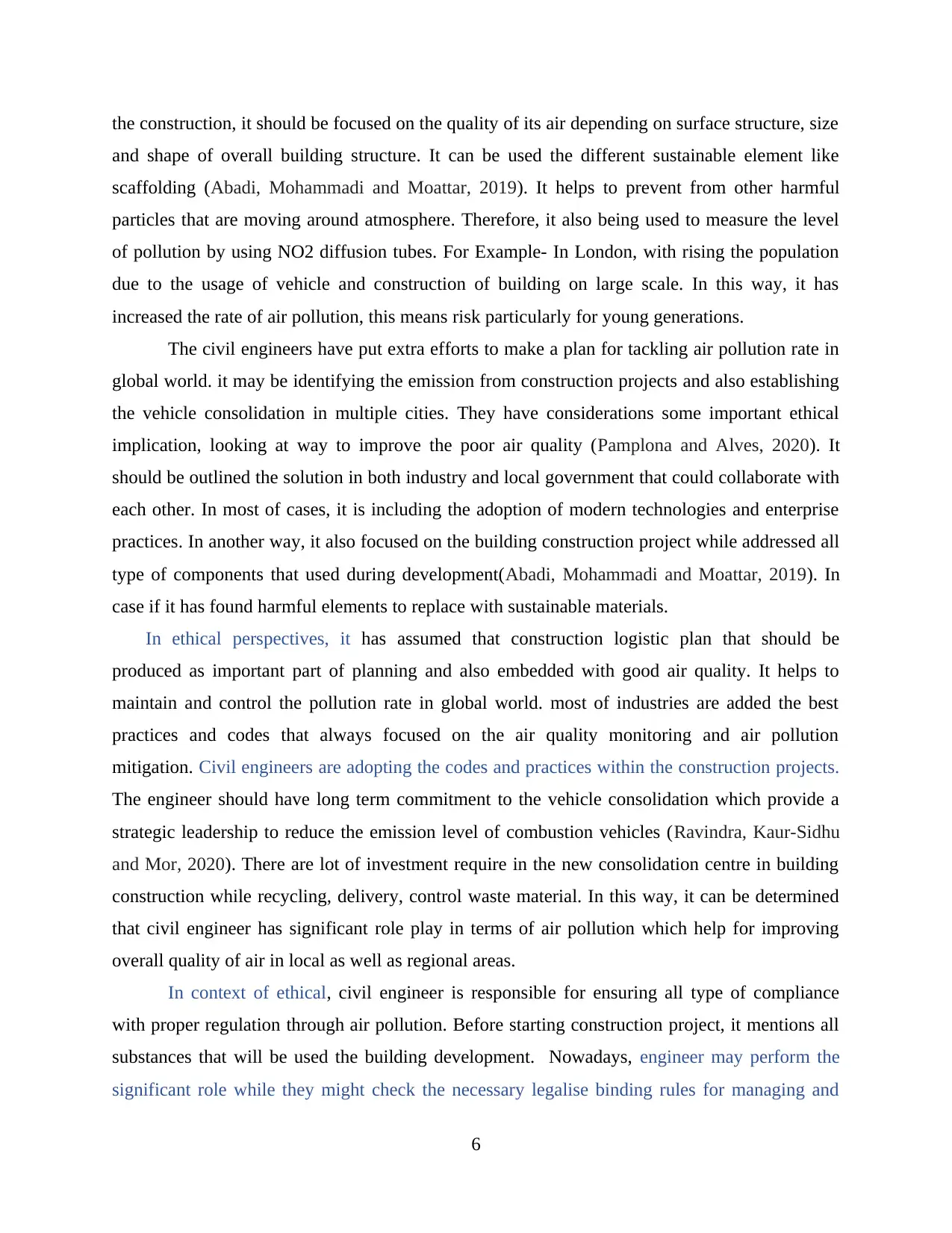
the construction, it should be focused on the quality of its air depending on surface structure, size
and shape of overall building structure. It can be used the different sustainable element like
scaffolding (Abadi, Mohammadi and Moattar, 2019). It helps to prevent from other harmful
particles that are moving around atmosphere. Therefore, it also being used to measure the level
of pollution by using NO2 diffusion tubes. For Example- In London, with rising the population
due to the usage of vehicle and construction of building on large scale. In this way, it has
increased the rate of air pollution, this means risk particularly for young generations.
The civil engineers have put extra efforts to make a plan for tackling air pollution rate in
global world. it may be identifying the emission from construction projects and also establishing
the vehicle consolidation in multiple cities. They have considerations some important ethical
implication, looking at way to improve the poor air quality (Pamplona and Alves, 2020). It
should be outlined the solution in both industry and local government that could collaborate with
each other. In most of cases, it is including the adoption of modern technologies and enterprise
practices. In another way, it also focused on the building construction project while addressed all
type of components that used during development(Abadi, Mohammadi and Moattar, 2019). In
case if it has found harmful elements to replace with sustainable materials.
In ethical perspectives, it has assumed that construction logistic plan that should be
produced as important part of planning and also embedded with good air quality. It helps to
maintain and control the pollution rate in global world. most of industries are added the best
practices and codes that always focused on the air quality monitoring and air pollution
mitigation. Civil engineers are adopting the codes and practices within the construction projects.
The engineer should have long term commitment to the vehicle consolidation which provide a
strategic leadership to reduce the emission level of combustion vehicles (Ravindra, Kaur-Sidhu
and Mor, 2020). There are lot of investment require in the new consolidation centre in building
construction while recycling, delivery, control waste material. In this way, it can be determined
that civil engineer has significant role play in terms of air pollution which help for improving
overall quality of air in local as well as regional areas.
In context of ethical, civil engineer is responsible for ensuring all type of compliance
with proper regulation through air pollution. Before starting construction project, it mentions all
substances that will be used the building development. Nowadays, engineer may perform the
significant role while they might check the necessary legalise binding rules for managing and
6
and shape of overall building structure. It can be used the different sustainable element like
scaffolding (Abadi, Mohammadi and Moattar, 2019). It helps to prevent from other harmful
particles that are moving around atmosphere. Therefore, it also being used to measure the level
of pollution by using NO2 diffusion tubes. For Example- In London, with rising the population
due to the usage of vehicle and construction of building on large scale. In this way, it has
increased the rate of air pollution, this means risk particularly for young generations.
The civil engineers have put extra efforts to make a plan for tackling air pollution rate in
global world. it may be identifying the emission from construction projects and also establishing
the vehicle consolidation in multiple cities. They have considerations some important ethical
implication, looking at way to improve the poor air quality (Pamplona and Alves, 2020). It
should be outlined the solution in both industry and local government that could collaborate with
each other. In most of cases, it is including the adoption of modern technologies and enterprise
practices. In another way, it also focused on the building construction project while addressed all
type of components that used during development(Abadi, Mohammadi and Moattar, 2019). In
case if it has found harmful elements to replace with sustainable materials.
In ethical perspectives, it has assumed that construction logistic plan that should be
produced as important part of planning and also embedded with good air quality. It helps to
maintain and control the pollution rate in global world. most of industries are added the best
practices and codes that always focused on the air quality monitoring and air pollution
mitigation. Civil engineers are adopting the codes and practices within the construction projects.
The engineer should have long term commitment to the vehicle consolidation which provide a
strategic leadership to reduce the emission level of combustion vehicles (Ravindra, Kaur-Sidhu
and Mor, 2020). There are lot of investment require in the new consolidation centre in building
construction while recycling, delivery, control waste material. In this way, it can be determined
that civil engineer has significant role play in terms of air pollution which help for improving
overall quality of air in local as well as regional areas.
In context of ethical, civil engineer is responsible for ensuring all type of compliance
with proper regulation through air pollution. Before starting construction project, it mentions all
substances that will be used the building development. Nowadays, engineer may perform the
significant role while they might check the necessary legalise binding rules for managing and
6
⊘ This is a preview!⊘
Do you want full access?
Subscribe today to unlock all pages.

Trusted by 1+ million students worldwide
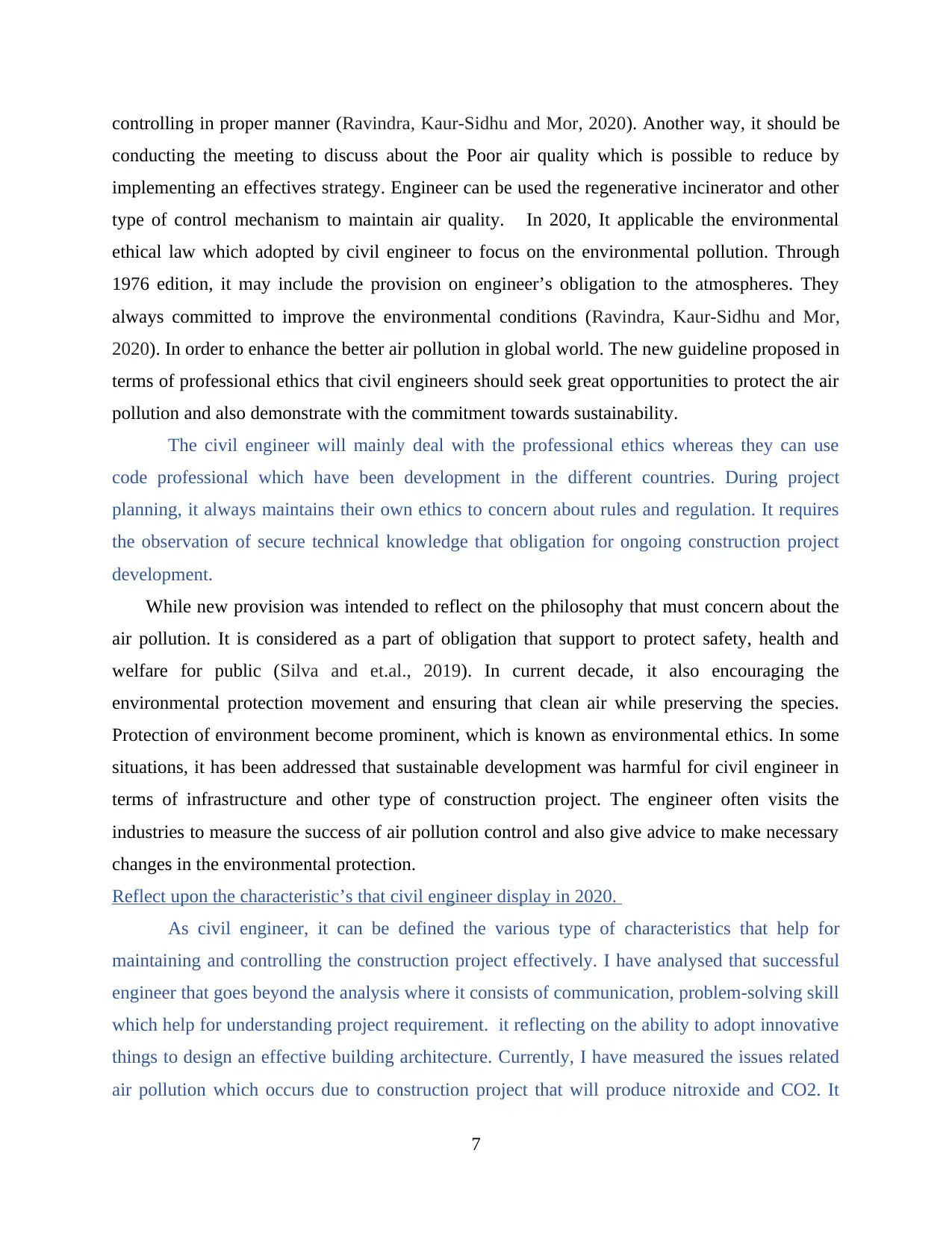
controlling in proper manner (Ravindra, Kaur-Sidhu and Mor, 2020). Another way, it should be
conducting the meeting to discuss about the Poor air quality which is possible to reduce by
implementing an effectives strategy. Engineer can be used the regenerative incinerator and other
type of control mechanism to maintain air quality. In 2020, It applicable the environmental
ethical law which adopted by civil engineer to focus on the environmental pollution. Through
1976 edition, it may include the provision on engineer’s obligation to the atmospheres. They
always committed to improve the environmental conditions (Ravindra, Kaur-Sidhu and Mor,
2020). In order to enhance the better air pollution in global world. The new guideline proposed in
terms of professional ethics that civil engineers should seek great opportunities to protect the air
pollution and also demonstrate with the commitment towards sustainability.
The civil engineer will mainly deal with the professional ethics whereas they can use
code professional which have been development in the different countries. During project
planning, it always maintains their own ethics to concern about rules and regulation. It requires
the observation of secure technical knowledge that obligation for ongoing construction project
development.
While new provision was intended to reflect on the philosophy that must concern about the
air pollution. It is considered as a part of obligation that support to protect safety, health and
welfare for public (Silva and et.al., 2019). In current decade, it also encouraging the
environmental protection movement and ensuring that clean air while preserving the species.
Protection of environment become prominent, which is known as environmental ethics. In some
situations, it has been addressed that sustainable development was harmful for civil engineer in
terms of infrastructure and other type of construction project. The engineer often visits the
industries to measure the success of air pollution control and also give advice to make necessary
changes in the environmental protection.
Reflect upon the characteristic’s that civil engineer display in 2020.
As civil engineer, it can be defined the various type of characteristics that help for
maintaining and controlling the construction project effectively. I have analysed that successful
engineer that goes beyond the analysis where it consists of communication, problem-solving skill
which help for understanding project requirement. it reflecting on the ability to adopt innovative
things to design an effective building architecture. Currently, I have measured the issues related
air pollution which occurs due to construction project that will produce nitroxide and CO2. It
7
conducting the meeting to discuss about the Poor air quality which is possible to reduce by
implementing an effectives strategy. Engineer can be used the regenerative incinerator and other
type of control mechanism to maintain air quality. In 2020, It applicable the environmental
ethical law which adopted by civil engineer to focus on the environmental pollution. Through
1976 edition, it may include the provision on engineer’s obligation to the atmospheres. They
always committed to improve the environmental conditions (Ravindra, Kaur-Sidhu and Mor,
2020). In order to enhance the better air pollution in global world. The new guideline proposed in
terms of professional ethics that civil engineers should seek great opportunities to protect the air
pollution and also demonstrate with the commitment towards sustainability.
The civil engineer will mainly deal with the professional ethics whereas they can use
code professional which have been development in the different countries. During project
planning, it always maintains their own ethics to concern about rules and regulation. It requires
the observation of secure technical knowledge that obligation for ongoing construction project
development.
While new provision was intended to reflect on the philosophy that must concern about the
air pollution. It is considered as a part of obligation that support to protect safety, health and
welfare for public (Silva and et.al., 2019). In current decade, it also encouraging the
environmental protection movement and ensuring that clean air while preserving the species.
Protection of environment become prominent, which is known as environmental ethics. In some
situations, it has been addressed that sustainable development was harmful for civil engineer in
terms of infrastructure and other type of construction project. The engineer often visits the
industries to measure the success of air pollution control and also give advice to make necessary
changes in the environmental protection.
Reflect upon the characteristic’s that civil engineer display in 2020.
As civil engineer, it can be defined the various type of characteristics that help for
maintaining and controlling the construction project effectively. I have analysed that successful
engineer that goes beyond the analysis where it consists of communication, problem-solving skill
which help for understanding project requirement. it reflecting on the ability to adopt innovative
things to design an effective building architecture. Currently, I have measured the issues related
air pollution which occurs due to construction project that will produce nitroxide and CO2. It
7
Paraphrase This Document
Need a fresh take? Get an instant paraphrase of this document with our AI Paraphraser
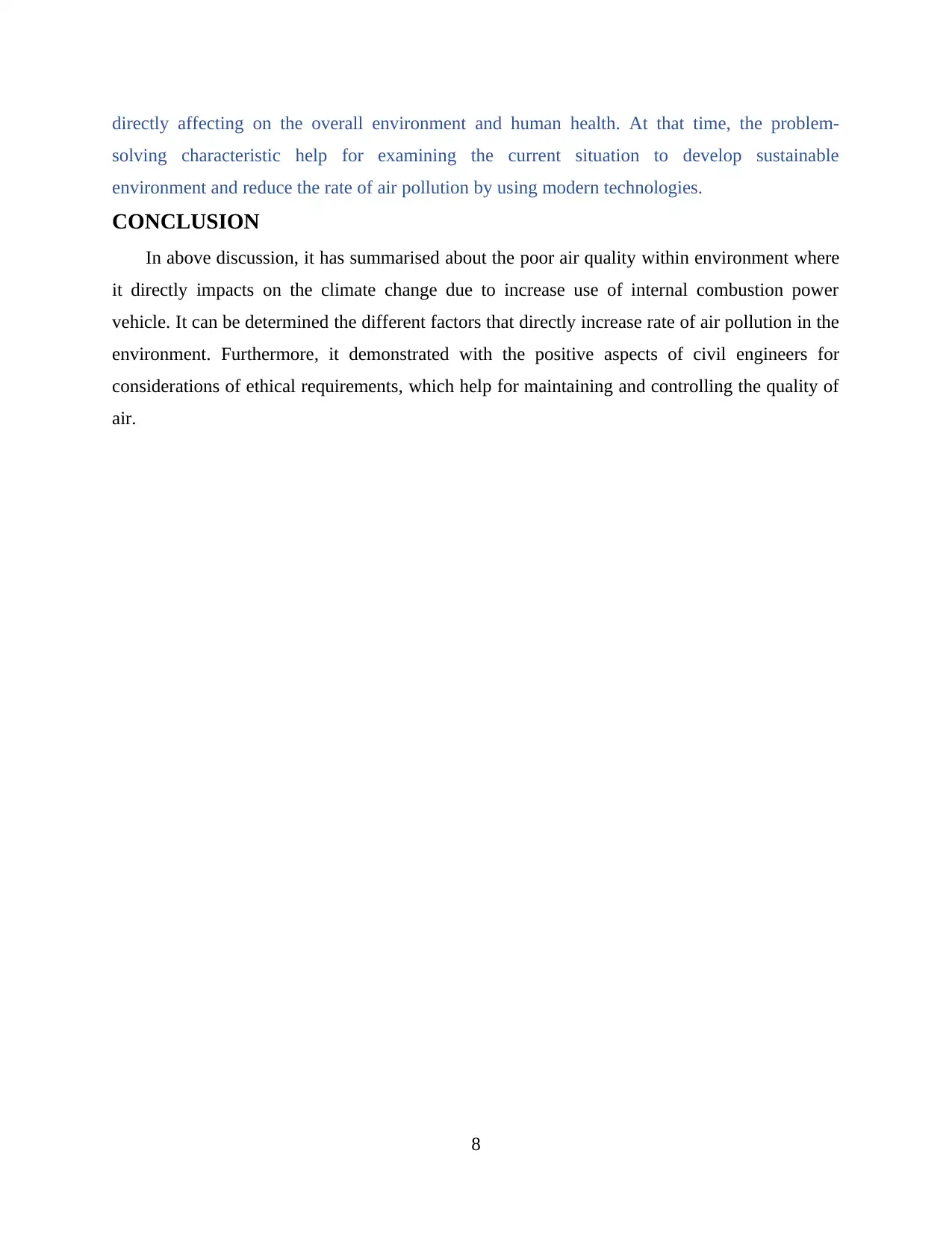
directly affecting on the overall environment and human health. At that time, the problem-
solving characteristic help for examining the current situation to develop sustainable
environment and reduce the rate of air pollution by using modern technologies.
CONCLUSION
In above discussion, it has summarised about the poor air quality within environment where
it directly impacts on the climate change due to increase use of internal combustion power
vehicle. It can be determined the different factors that directly increase rate of air pollution in the
environment. Furthermore, it demonstrated with the positive aspects of civil engineers for
considerations of ethical requirements, which help for maintaining and controlling the quality of
air.
8
solving characteristic help for examining the current situation to develop sustainable
environment and reduce the rate of air pollution by using modern technologies.
CONCLUSION
In above discussion, it has summarised about the poor air quality within environment where
it directly impacts on the climate change due to increase use of internal combustion power
vehicle. It can be determined the different factors that directly increase rate of air pollution in the
environment. Furthermore, it demonstrated with the positive aspects of civil engineers for
considerations of ethical requirements, which help for maintaining and controlling the quality of
air.
8
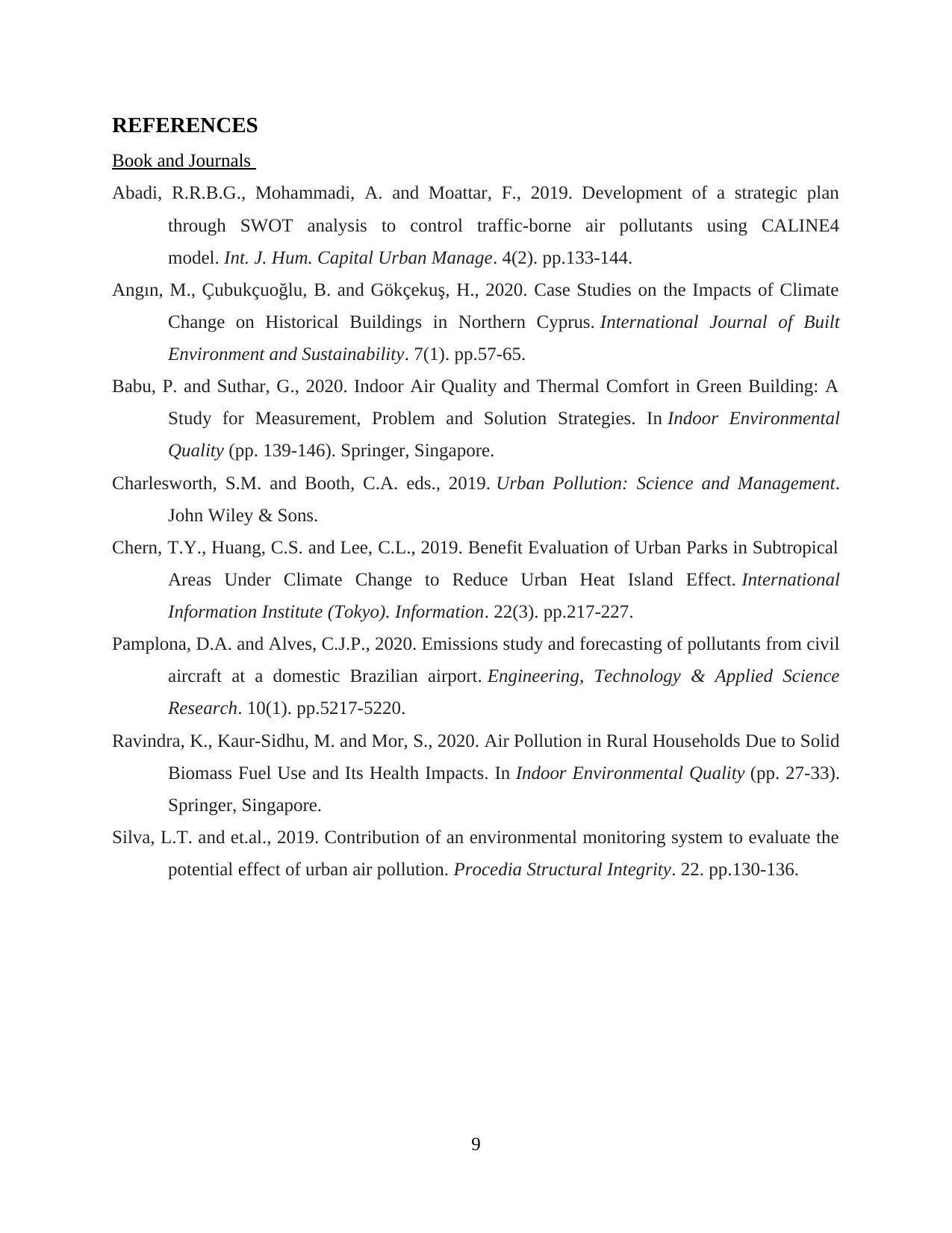
REFERENCES
Book and Journals
Abadi, R.R.B.G., Mohammadi, A. and Moattar, F., 2019. Development of a strategic plan
through SWOT analysis to control traffic-borne air pollutants using CALINE4
model. Int. J. Hum. Capital Urban Manage. 4(2). pp.133-144.
Angın, M., Çubukçuoğlu, B. and Gökçekuş, H., 2020. Case Studies on the Impacts of Climate
Change on Historical Buildings in Northern Cyprus. International Journal of Built
Environment and Sustainability. 7(1). pp.57-65.
Babu, P. and Suthar, G., 2020. Indoor Air Quality and Thermal Comfort in Green Building: A
Study for Measurement, Problem and Solution Strategies. In Indoor Environmental
Quality (pp. 139-146). Springer, Singapore.
Charlesworth, S.M. and Booth, C.A. eds., 2019. Urban Pollution: Science and Management.
John Wiley & Sons.
Chern, T.Y., Huang, C.S. and Lee, C.L., 2019. Benefit Evaluation of Urban Parks in Subtropical
Areas Under Climate Change to Reduce Urban Heat Island Effect. International
Information Institute (Tokyo). Information. 22(3). pp.217-227.
Pamplona, D.A. and Alves, C.J.P., 2020. Emissions study and forecasting of pollutants from civil
aircraft at a domestic Brazilian airport. Engineering, Technology & Applied Science
Research. 10(1). pp.5217-5220.
Ravindra, K., Kaur-Sidhu, M. and Mor, S., 2020. Air Pollution in Rural Households Due to Solid
Biomass Fuel Use and Its Health Impacts. In Indoor Environmental Quality (pp. 27-33).
Springer, Singapore.
Silva, L.T. and et.al., 2019. Contribution of an environmental monitoring system to evaluate the
potential effect of urban air pollution. Procedia Structural Integrity. 22. pp.130-136.
9
Book and Journals
Abadi, R.R.B.G., Mohammadi, A. and Moattar, F., 2019. Development of a strategic plan
through SWOT analysis to control traffic-borne air pollutants using CALINE4
model. Int. J. Hum. Capital Urban Manage. 4(2). pp.133-144.
Angın, M., Çubukçuoğlu, B. and Gökçekuş, H., 2020. Case Studies on the Impacts of Climate
Change on Historical Buildings in Northern Cyprus. International Journal of Built
Environment and Sustainability. 7(1). pp.57-65.
Babu, P. and Suthar, G., 2020. Indoor Air Quality and Thermal Comfort in Green Building: A
Study for Measurement, Problem and Solution Strategies. In Indoor Environmental
Quality (pp. 139-146). Springer, Singapore.
Charlesworth, S.M. and Booth, C.A. eds., 2019. Urban Pollution: Science and Management.
John Wiley & Sons.
Chern, T.Y., Huang, C.S. and Lee, C.L., 2019. Benefit Evaluation of Urban Parks in Subtropical
Areas Under Climate Change to Reduce Urban Heat Island Effect. International
Information Institute (Tokyo). Information. 22(3). pp.217-227.
Pamplona, D.A. and Alves, C.J.P., 2020. Emissions study and forecasting of pollutants from civil
aircraft at a domestic Brazilian airport. Engineering, Technology & Applied Science
Research. 10(1). pp.5217-5220.
Ravindra, K., Kaur-Sidhu, M. and Mor, S., 2020. Air Pollution in Rural Households Due to Solid
Biomass Fuel Use and Its Health Impacts. In Indoor Environmental Quality (pp. 27-33).
Springer, Singapore.
Silva, L.T. and et.al., 2019. Contribution of an environmental monitoring system to evaluate the
potential effect of urban air pollution. Procedia Structural Integrity. 22. pp.130-136.
9
⊘ This is a preview!⊘
Do you want full access?
Subscribe today to unlock all pages.

Trusted by 1+ million students worldwide
1 out of 9
Related Documents
Your All-in-One AI-Powered Toolkit for Academic Success.
+13062052269
info@desklib.com
Available 24*7 on WhatsApp / Email
![[object Object]](/_next/static/media/star-bottom.7253800d.svg)
Unlock your academic potential
Copyright © 2020–2025 A2Z Services. All Rights Reserved. Developed and managed by ZUCOL.





